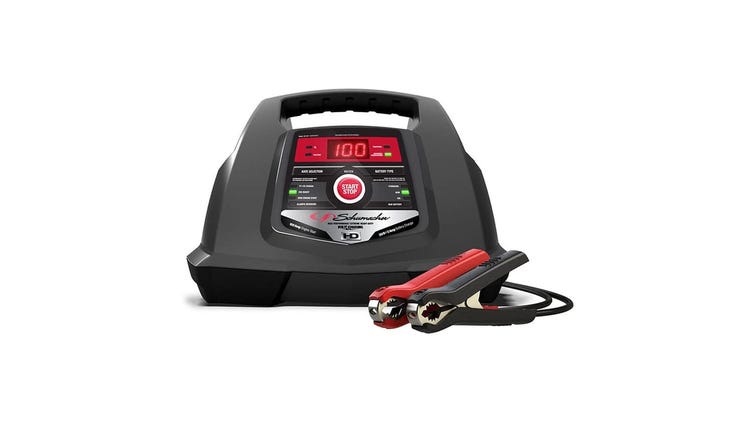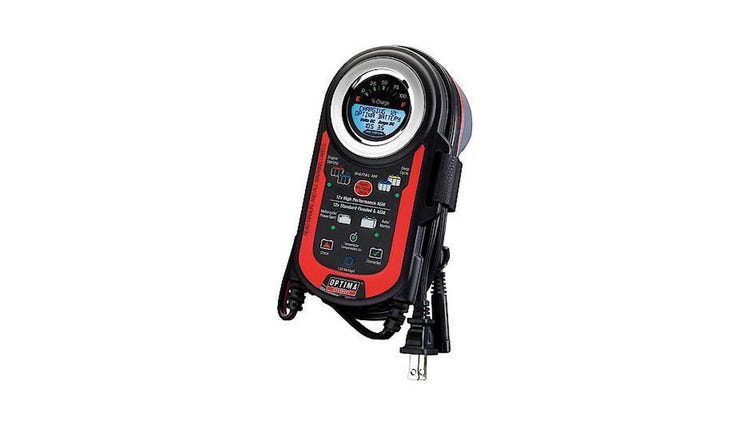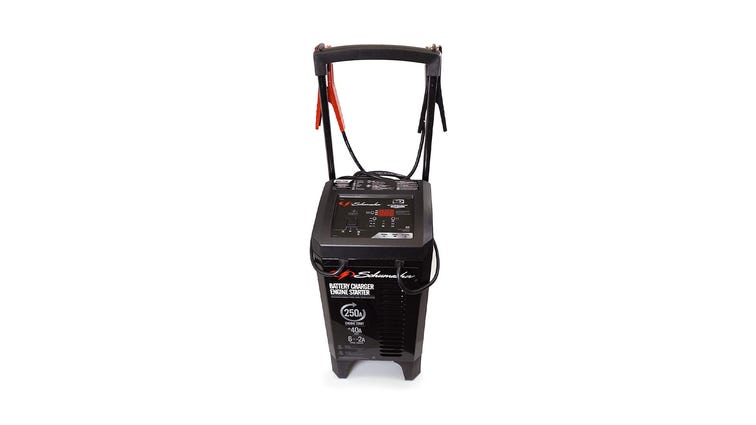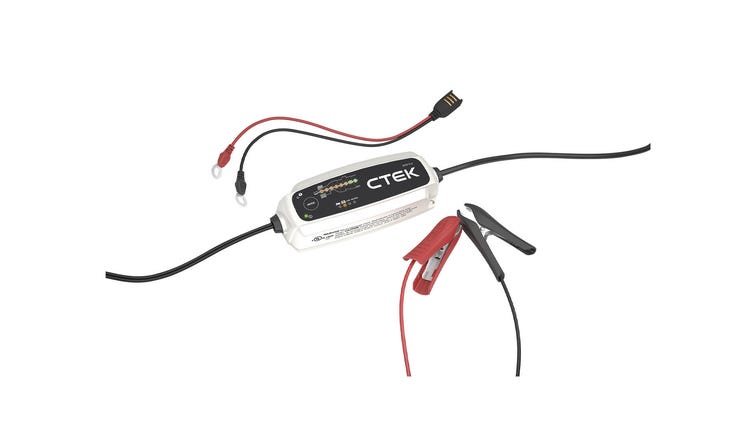Thanks to the proliferation of cell phones, it’s a lot easier than in the past to get a jump or tow, but no one wants to wind up with a dead battery. Waiting around for help can be a time-consuming and frustrating experience — particularly when you have somewhere you need to go.
The good news is that a portable battery charger can help you avoid the hassles that come with a dead battery, like trying to flag down a helpful stranger or waiting for someone to show up with jumper cables. A portable charger is also much easier than jump starting since you don’t have to string bulky cables from one vehicle to another. And it’s much more compact than you might think. But that’s not all.
“A jump starter provides a lot of amperage [to start the car] and thus they are rather rough on batteries,” says Mike Arman, an electronics expert, vocational school teacher and author of Motorcycle Electrics Without Pain. Arman has built fuel injection systems and wired countless cars, motorcycles and airplanes.
“You are much better off putting it on a regular charger and being patient [if possible]. If your car needs repeated jump starts, the battery may be bad or there may be a problem with the charging system,” Arman says.
There are several kinds of portable car battery chargers, including a solar battery charger. That said, if you’re going to pick up a portable charger, you want to make sure it’s the right one. Here’s a list of some of the best car battery chargers, depending on your specific car battery and charging mode needs, and based on user reviews and expert opinions. And make sure to keep reading for a deeper dive into the different car charger types.
Read more: Best battery maintainers in 2022

 \n ","topic":"","ttag":"","variant":"","viewguid":"","event":"listicle|image|1","correlationId":"","_destCat":"https:\/\/www.ebay.com\/itm\/Deltran-Battery-Tender-Plus-12V-1-25A-Automatic-Battery-Charger-Free-Shipping\/293588850460","productName":"Best car battery charger overall","formatType":"IMAGE","location":"LIST","position":1,"sku":"","dwLinkTag":"article-body|listicle|image","selector":"#article-body #listicle-9e2fe061-23e0-4021-a75c-7d6337867307 .itemImage"}}” rel=”noopener nofollow” target=”_blank”>
\n ","topic":"","ttag":"","variant":"","viewguid":"","event":"listicle|image|1","correlationId":"","_destCat":"https:\/\/www.ebay.com\/itm\/Deltran-Battery-Tender-Plus-12V-1-25A-Automatic-Battery-Charger-Free-Shipping\/293588850460","productName":"Best car battery charger overall","formatType":"IMAGE","location":"LIST","position":1,"sku":"","dwLinkTag":"article-body|listicle|image","selector":"#article-body #listicle-9e2fe061-23e0-4021-a75c-7d6337867307 .itemImage"}}” rel=”noopener nofollow” target=”_blank”>


Battery Tender
When it comes to picking the best battery charger, the kind of vehicle you drive typically doesn’t play a major role. After all, most cars, motorcycles, SUVs, trucks and other road vehicles use lead-acid batteries, which are relatively resilient and inexpensive to manufacture. A charger that can power up a lead acid 12 volt battery in an SUV can do the same for one in a motorcycle, for instance.
The best overall charger for your vehicle’s lead-acid battery is the Battery Tender Plus (it works with multiple types of lead-acid batteries, including absorbent glass mat and flooded). It’s an automatic charger, with a charge controller which means it will shut down on its own when your battery charge is full, preventing overcharging. It even has a “float” battery maintainer mode that will keep it at full power during periods of inactivity, compensating for the self-discharge associated with lead-acid batteries.
The 1.25 amps of power provided ensures a “low and slow” charge, which is best for the health of your vehicle’s battery. It’s easy and safe to connect and disconnect, spark-proof, and checks to make sure a connection is established before transmitting power. It’s also cited as working well in extreme temperatures — both hot and cold.
The efficacy and user-friendliness of the Battery Tender Plus have earned it a good deal of popularity on Amazon: it’s currently the site’s fourth best-selling car battery charger, with a rating of 4.7 out of 5 stars based on over 7,500 customer reviews.

 \n ","topic":"","ttag":"","variant":"","viewguid":"","event":"listicle|image|2","correlationId":"","_destCat":"https:\/\/www.amazon.com\/dp\/B07W46BX31","productName":"Best car battery charger on a budget","formatType":"IMAGE","location":"LIST","position":2,"sku":"","dwLinkTag":"article-body|listicle|image","selector":"#article-body #listicle-b69918cc-9226-4da7-9691-24b40e46dee2 .itemImage"}}” rel=”noopener nofollow” target=”_blank”>
\n ","topic":"","ttag":"","variant":"","viewguid":"","event":"listicle|image|2","correlationId":"","_destCat":"https:\/\/www.amazon.com\/dp\/B07W46BX31","productName":"Best car battery charger on a budget","formatType":"IMAGE","location":"LIST","position":2,"sku":"","dwLinkTag":"article-body|listicle|image","selector":"#article-body #listicle-b69918cc-9226-4da7-9691-24b40e46dee2 .itemImage"}}” rel=”noopener nofollow” target=”_blank”>


NOCO
The NOCO Genius1 is currently the best-selling battery charger on Amazon, and there’s little wonder why — not only is it a reliable automatic car charger that makes charging an easy and stable process, but it does it for only $30 or less.
What makes the Genius1 so popular (besides its price) is its versatility. It works with all sorts of batteries — including lithium-ion, AGM and deep-cycle — and both 6- and 12-volt battery types. It charges and maintains batteries, with a trickle charge feature that keeps your battery charged over long periods of inactivity. It also uses sensors to measure the temperature and adjust its 1-amp charge accordingly.
Another feature that makes the Genius1 portable car battery charger useful is the fact that it can charge completely dead batteries. Typically, this is a problem for automatic chargers, but the Genius1 has a “force mode” that allows it to function as a manual charger. This means that it will deliver a continuous charge that proceeds unabated until you switch it off, and it can be used to resuscitate a battery with zero battery voltage.
NOCO’s Genius line also features models with higher amperage, providing more power and, if you desire, a faster charge. It’s the Genius1, however, that delivers the best bang for your buck, making it an excellent introductory product when it comes to charging your own battery.

 \n ","topic":"","ttag":"","variant":"","viewguid":"","event":"listicle|image|3","correlationId":"","_destCat":"https:\/\/www.walmart.com\/ip\/Schumacher-Battery-Charger-Engine-Starter-Boost-Maintainer-and-Auto-Desulfator-100-Amp-30-Amp-6V-12V\/784428205","productName":"Best car battery charger for home use","formatType":"IMAGE","location":"LIST","position":3,"sku":"","dwLinkTag":"article-body|listicle|image","selector":"#article-body #listicle-92b3562f-0e64-4e21-b4cc-8fa117c6b101 .itemImage"}}” rel=”noopener nofollow” target=”_blank”>
\n ","topic":"","ttag":"","variant":"","viewguid":"","event":"listicle|image|3","correlationId":"","_destCat":"https:\/\/www.walmart.com\/ip\/Schumacher-Battery-Charger-Engine-Starter-Boost-Maintainer-and-Auto-Desulfator-100-Amp-30-Amp-6V-12V\/784428205","productName":"Best car battery charger for home use","formatType":"IMAGE","location":"LIST","position":3,"sku":"","dwLinkTag":"article-body|listicle|image","selector":"#article-body #listicle-92b3562f-0e64-4e21-b4cc-8fa117c6b101 .itemImage"}}” rel=”noopener nofollow” target=”_blank”>


Schumacher
Battery chargers come in different sizes and power levels, with some of the larger ones possessing the juice required to charge a car battery as quickly as possible. However, some automotive battery chargers are so large that they’re better used in auto garages than in consumers’ homes. Finding a powerful automotive battery charger that also makes sense for home use is a delicate balance.
The Schumacher SC1281 model offers the best of both worlds — high power and handy maneuverability. The product can charge a car battery slowly with 2-12 amps of power, but can also provide 30 amps for a quick boost — or even 100 to act like a jump starter. The charging unit itself weighs about 12 pounds and has a handle to make carrying it easier.
Despite the power that it delivers, the Schumacher SC1281 charges with finesse: it’s an automatic smart battery charger so you don’t need to worry about overcharging your battery, and the trickle charge feature lets you easily keep an unused battery juiced up. The charger’s reverse polarity protection ensures that it can’t be used if the clamps are attached to the wrong car battery terminal, helping it function more safely.
At $80, the Schumacher SC1281 is pricier than some of the other products on this list, but the fact that it’s still the eighth best-selling car battery charger on Amazon proves that it’s worth the cost.

 \n ","topic":"","ttag":"","variant":"","viewguid":"","event":"listicle|image|4","correlationId":"","_destCat":"https:\/\/www.walmart.com\/ip\/Deltran-Battery-Tender-Junior-12V-Automatic-Battery-Charger\/108265818?wmlspartner=wlpa&selectedSellerId=0&wl13=5438&&adid=22222222227000000000&wl0=&wl1=g&wl2=c&wl3=42423897272&wl4=aud-393207457166:pla-51320962143&wl5=9018827&wl6=&wl7=&wl8=&wl9=pla&wl10=8175035&wl11=local&wl12=108265818&veh=sem&gclid=Cj0KCQiAxc6PBhCEARIsAH8Hff0pW-u1i80Q5lVbLOriKLbC3ruDie6mM8IppYnqr9cVyavTrKNltisaAk9dEALw_wcB&gclsrc=aw.ds","productName":"Best car battery charger for long-term storage","formatType":"IMAGE","location":"LIST","position":4,"sku":"","dwLinkTag":"article-body|listicle|image","selector":"#article-body #listicle-cac16572-f41e-478c-90a6-84b89a0f0826 .itemImage"}}” rel=”noopener nofollow” target=”_blank”>
\n ","topic":"","ttag":"","variant":"","viewguid":"","event":"listicle|image|4","correlationId":"","_destCat":"https:\/\/www.walmart.com\/ip\/Deltran-Battery-Tender-Junior-12V-Automatic-Battery-Charger\/108265818?wmlspartner=wlpa&selectedSellerId=0&wl13=5438&&adid=22222222227000000000&wl0=&wl1=g&wl2=c&wl3=42423897272&wl4=aud-393207457166:pla-51320962143&wl5=9018827&wl6=&wl7=&wl8=&wl9=pla&wl10=8175035&wl11=local&wl12=108265818&veh=sem&gclid=Cj0KCQiAxc6PBhCEARIsAH8Hff0pW-u1i80Q5lVbLOriKLbC3ruDie6mM8IppYnqr9cVyavTrKNltisaAk9dEALw_wcB&gclsrc=aw.ds","productName":"Best car battery charger for long-term storage","formatType":"IMAGE","location":"LIST","position":4,"sku":"","dwLinkTag":"article-body|listicle|image","selector":"#article-body #listicle-cac16572-f41e-478c-90a6-84b89a0f0826 .itemImage"}}” rel=”noopener nofollow” target=”_blank”>


Battery Tender
Deltran’s Battery Tender Plus ranks as our top overall car battery charger, but the company’s Battery Tender Junior is the perfect choice if you’re simply concerned about long-term battery storage.
Like the Plus model, the Battery Tender Junior is a fully automatic battery charger with a “float” feature that allows for it to be left attached to the battery terminals, charging as it depletes and only as necessary. The Junior is a smaller, more affordable model, though, and while the 0.75 amperage of power won’t allow for a quick charge, you won’t need any more than that if you’re leaving it plugged in for an extended period of time.
The Battery Tender Junior is also quite versatile, as it can be used on standard lead-acid, flooded and sealed maintenance-free batteries, so long as they’re 12-volt. It’s also got an LED indicator that allows you to monitor the power level of your battery — which can tell you when your vehicle is ready for use, but doesn’t change the fact that the smart device handles the entire charging process for you.
The Battery Tender Junior is Amazon’s second-best-selling charger, with 4.7 out of 5 stars based on over 18,000 customer ratings. It’s also available at a discount on the site — and at $44, it’s one of the cheapest models on this list.

 \n ","topic":"","ttag":"","variant":"","viewguid":"","event":"listicle|image|5","correlationId":"","_destCat":"https:\/\/www.amazon.com\/dp\/B00DHGPVKI","productName":"Best car battery charger for dead batteries","formatType":"IMAGE","location":"LIST","position":5,"sku":"","dwLinkTag":"article-body|listicle|image","selector":"#article-body #listicle-d97c42e0-3a41-45a7-90ac-8bd690af13c7 .itemImage"}}” rel=”noopener nofollow” target=”_blank”>
\n ","topic":"","ttag":"","variant":"","viewguid":"","event":"listicle|image|5","correlationId":"","_destCat":"https:\/\/www.amazon.com\/dp\/B00DHGPVKI","productName":"Best car battery charger for dead batteries","formatType":"IMAGE","location":"LIST","position":5,"sku":"","dwLinkTag":"article-body|listicle|image","selector":"#article-body #listicle-d97c42e0-3a41-45a7-90ac-8bd690af13c7 .itemImage"}}” rel=”noopener nofollow” target=”_blank”>


Optima
Automatic car battery chargers make the battery charging process easier by shutting off when your vehicle battery is at 100%, but most of them just aren’t able to charge a dead battery. While manual chargers simply send electricity into a source indiscriminately, automatic chargers need to locate a battery first, and many of them can’t do that with a dead battery.
The Optima Digital 400 is the exception to that rule. It’s an automatic smart battery charger with charge controller that will fill up your battery and then stop, allowing you to charge it overnight without worrying about damaging the power bank. It’s also able to locate and charge dead batteries, with Amazon customer reviews touting the charger’s ability to resurrect units previously thought dead — and thereby save their owners money.
The Optima Digital 400 is easy to use, as well. The LCD screen keeps the user updated on the progress of the charging process, and the unit also offers an easy-to-select range of battery types from which to choose (it works on standard lead-acid, 12 V battery, deep-cycle, AGM battery types and more). Finally, the 4-amp maximum charge makes the entire charging process faster than with other models.

 \n ","topic":"","ttag":"","variant":"","viewguid":"","event":"listicle|image|6","correlationId":"","_destCat":"https:\/\/www.amazon.com\/dp\/B07DLTXNVY\/","productName":"Best car battery charger for fast charging","formatType":"IMAGE","location":"LIST","position":6,"sku":"","dwLinkTag":"article-body|listicle|image","selector":"#article-body #listicle-79ab2149-0d1f-47cf-876b-c14780605df9 .itemImage"}}” rel=”noopener nofollow” target=”_blank”>
\n ","topic":"","ttag":"","variant":"","viewguid":"","event":"listicle|image|6","correlationId":"","_destCat":"https:\/\/www.amazon.com\/dp\/B07DLTXNVY\/","productName":"Best car battery charger for fast charging","formatType":"IMAGE","location":"LIST","position":6,"sku":"","dwLinkTag":"article-body|listicle|image","selector":"#article-body #listicle-79ab2149-0d1f-47cf-876b-c14780605df9 .itemImage"}}” rel=”noopener nofollow” target=”_blank”>


Schumacher
Let’s get the obvious out of the way first: the Schumacher SC1325 is big. It weighs almost 30 pounds, and, including the handle, it’s almost 2 feet tall. It’s also the most expensive charger on the list, coming in at just about $200. For those reasons, the SC1325 might seem more at home in an auto garage than in your own home (or trunk).
That said, if you’re looking to get moving quickly, you can’t beat the SC1325 (also, it’s got wheels, which makes the weight more manageable). While it has charging and maintenance modes that deliver 2 or 6 amps of power, it can also provide a boost of 40 amps to revive a battery, or — if necessary — a 250-amp jump start that will get even large engines running again. These fast charges have risks for your battery and vehicle (more on that later), but in an emergency, they may be necessary.
The Schumacher SC1325 handles a wide array of batteries, including standard lead-acid, AGM, gel and deep-cycle units. That still doesn’t mean it’s necessarily the right choice for you. What it comes down to, in the end, is if the SC1325 suits your specific needs. If it doesn’t, you’ll be fine with a smaller, less expensive model. If you want a heavy-duty charger/jump starter that’s going to get you moving quickly should the need arise, this may be just right for you.

 \n ","topic":"","ttag":"","variant":"","viewguid":"","event":"listicle|image|7","correlationId":"","_destCat":"https:\/\/www.amazon.com\/dp\/B00CD44RQO","productName":"Best car battery charger for RVs","formatType":"IMAGE","location":"LIST","position":7,"sku":"","dwLinkTag":"article-body|listicle|image","selector":"#article-body #listicle-f78e6f50-beaa-48e5-8457-5aaa2a55e8b2 .itemImage"}}” rel=”noopener nofollow” target=”_blank”>
\n ","topic":"","ttag":"","variant":"","viewguid":"","event":"listicle|image|7","correlationId":"","_destCat":"https:\/\/www.amazon.com\/dp\/B00CD44RQO","productName":"Best car battery charger for RVs","formatType":"IMAGE","location":"LIST","position":7,"sku":"","dwLinkTag":"article-body|listicle|image","selector":"#article-body #listicle-f78e6f50-beaa-48e5-8457-5aaa2a55e8b2 .itemImage"}}” rel=”noopener nofollow” target=”_blank”>


CTEK
While most road vehicles run on standard, lead-acid batteries, recreational vehicles are the exception. RVs use deep-cycle batteries, a type of lead-acid battery designed to provide power over longer periods of time. Deep-cycle batteries are also meant to be completely depleted and charged up many times, while regular lead-acid batteries aren’t meant to be totally drained as part of regular use.
It should come as no surprise that an RV battery needs a charger that can handle deep-cycle batteries, which the CTEK 40-206 MXS 5.0 does (in addition to charging all types of lead-acid batteries). It offers an eight-step automatic charging process, with an indicator allowing the user to see exactly how the battery is progressing and when the vehicle can be used. It also has a float system that keeps the battery at 95% to 100% capacity after the initial charge (which has a maximum current of 4.3 amps) is finished.
In the end, what speaks highest of the CTEK 40-206 MXS 5.0 is customer satisfaction. With more than 600 ratings, the charger currently has 4.8 out of 5 stars on Amazon, making it overwhelmingly endorsed by those who have bought and used it — and there aren’t many more compelling arguments than that.
Comparison of the best car battery chargers
| Brand | Model | Price | |
| Best car battery charger overall | Battery Tender | Plus | $65 |
| Best car battery charger on a budget | NOCO | Genius1 | $25 |
| Best car battery charger for home use | Schumacher | SC1281 | $80 |
| Best car battery charger for long-term storage | Battery Tender | Junior | $44 |
| Best car battery charger for dead batteries | Optima | Digital 400 | $100 |
| Best car battery charger for fast charging | Schumacher | SC1325 | $192 |
| Best car battery charger for RVs | CTEK | 40-206 MXS 5.0 | $84 |
The Battery Tender Plus is our pick for best overall battery charger.
Battery TenderWhat types of car battery chargers are there?
There’s no question that there are a lot of different car battery chargers out there, and the one that’s right for you depends on your vehicle, your usage of it and the price you want to spend. However, no matter what you choose, it will fall into one of the two major categories of battery chargers — automatic and manual.
Automatic (or “smart”) chargers are able to gauge the level of the charge in your car’s battery as a float charger and act appropriately, keeping it from draining entirely or overcharging. Either of these can be harmful to your battery, depending on the type you have, so having a smart charger that eliminates those risks can be better for your battery in the long run.
Manual chargers, on the other hand, simply transfer their power to a battery until they’re disconnected or depleted. While this can potentially be detrimental to a battery in the case of overcharging, it also provides an advantage: some smart chargers will have trouble locating (and subsequently charging) batteries that are completely dead, but this isn’t a concern for manual chargers.
When shopping for a car battery charger you’ll have to decide if you want a manual or automatic charger.
CTEKAs a rule, it’s better for a vehicle’s battery to be charged slowly than quickly, if you can spare the time. “A jump start or using a fast charger on modern cars can fry all kinds of delicate electronics, and then you may be looking at some real money,” says Arman. “Modern cars are actually computers which just happen to have some wheels attached. You can do thousands of dollars of damage to the electronics if you are careless or sloppy with jump starts or quick chargers.”
A slow charge can be accomplished with a trickle charger. Trickle chargers come in both automatic and manual varieties, and are designed to recharge batteries slowly, over longer periods of time.
Automatic trickle chargers are effective for vehicles that will go unused for several months at a time, as they can offset the natural rate of self-discharge that the batteries experience. The self-discharge adds up, and can potentially drain your battery entirely by the time you try to use your vehicle again. Since these chargers are automatic, they’ll only fill up enough to compensate for the small amount of battery life that’s discharged before turning off again.
You can leave automatic trickle chargers plugged in, due to their safety features. “If the battery charger is plugged into a grounded wall outlet and attached properly, you can leave the charger attached until the battery is fully charged,” says Lauren Fix, creator of Car Coach Reports. Fix is a television and radio host and auto columnist who has been featured on Forbes, Inside Edition and ABC.com. “A top-quality charger will have a shut off when it reaches a fully charged status.”
The NOCO Genius1 is a great affordable car battery charger option.
NOCOHow to charge a battery
It’s OK to charge a battery that’s still attached to a vehicle, but make sure the vehicle is off. If you’re worried about the cold of a garage affecting the battery’s health (if you’re storing a vehicle, such as an RV, for the winter), you can also detach the battery and leave it charging indoors — but this presents risks of its own.
“On newer cars, disconnecting the battery to charge it will lose all the memories in all the electronic doo-dads in the car,” says Arman. “If you are lucky, all you will have to do is reset the radio stations. If you are not lucky, you’ll get a bazillion error messages and you might be looking at a tow to the dealership to have all kinds of things redone before you can drive the car again.”
Charging the battery itself is a fairly simple job, but can also be potentially dangerous, so you’ll need to make sure you’re careful. Any task that involves working with electrical current poses a shock risk, and spilled battery acid is harmful to skin.
If you need to charge a battery and you’re short on time, the Schumacher SC1325 is the charger for you.
SchumacherYour charger will come with detailed instructions that should be followed, but there are a few rules that are more or less universal (again, though, included instructions should supersede everything else). To start, you’ll always want to make sure that your charger is off — otherwise, you’ll risk subjecting yourself to an electric shock. Then, you’ll connect the charger’s positive clamp to the battery’s positive terminal and the charger’s negative clamp to the battery’s negative terminal. Usually, the charger’s positive clamp will be red and the negative clamp will be black.
After the charger is connected to the battery, individual instructions may vary. Some chargers may have settings to adjust that will determine the rate at which the battery is refilled, while others can just be turned on. Either way, at this point you’ll be ready to start charging.
The amount of time you’ll need to take to fully charge your battery depends on the existing charge level and the rate of your charger. Let’s say you have a 12-volt battery that holds about 48 amps of power. If your battery is completely drained and your charger can replenish 4 amps per hour, a full charge will take 12 hours. If your charger has an adjustable amperage rate, you can determine how long it will take to fully charge. Again, it’s better to charge your battery slowly, but in the event that you need a quick charge, you can set your device to a high rate. Just make sure that you keep an eye on it if it’s a manual charger in order to prevent overcharging.
The Optima Digital 400 is the charger you’ll need if you need to revive a dead battery.
OptimaCar batteries won’t need to be charged very often if your car is used regularly — typically, you’ll just need to use the charger if the car won’t start, which shouldn’t happen until after years of use. Some telltale signs that your battery is running low include a slowing of your engine cranking speed and a dimming of your headlights. You can also purchase a battery tester if you’re concerned about getting stranded.
When it comes to motorcycles, RVs, boats or any other vehicles that are likely to go long periods of time without use, though, drainage is a major concern. Like cars, these vehicles typically use lead-acid batteries, which experience self-discharge when not in use. It’s recommended that you charge these batteries every 30 days in order to prevent battery death and preserve overall battery health. Like with stored cars, you can also leave these vehicles’ batteries hooked up to automatic chargers or a car battery maintainer.
If a vehicle is in long-term storage, charge the battery every 30 days or put it on a battery maintainer.
Schumacher5 thing you need to know before you buy a car battery charger
- What kind of battery type does your vehicle use? Most likely, the answer is a regular lead-acid battery, but if you drive an RV, it probably has a deep-cycle battery. In any event, you’ll have to make sure any charger you consider is compatible with your battery.
- Do you want a manual or automatic smart battery charger? Automatic chargers are typically easier to use, as they regulate their charge to prevent battery-damaging overcharging, but manual chargers are better for reviving dead batteries.
- How much power do you need in a charger? Do you want one that charges a battery slowly and keeps it maintained while it’s not in use? Or do you want a charger that can power up a battery quickly and possibly provide a jump start, as well?
- What size battery charger do you prefer? Though all of the models on the list are technically portable chargers, some are much larger than others and might therefore be more difficult to use. More powerful chargers are generally larger.
- What do you want to spend on a battery charger? Again, there’s typically a direct relationship between the power provided and the cost of the unit, so if you want to charge more quickly, you’ll need to spend a bit more.
Written by Scott Fried for Roadshow.